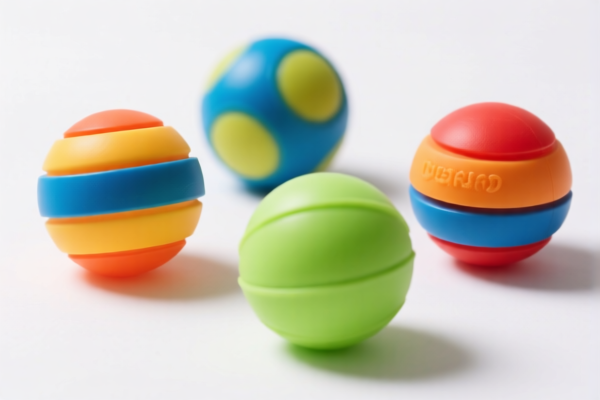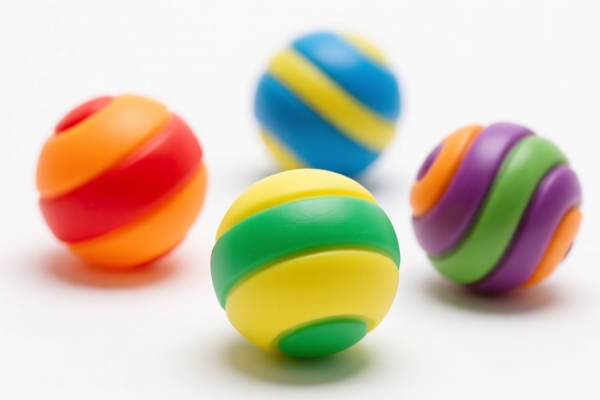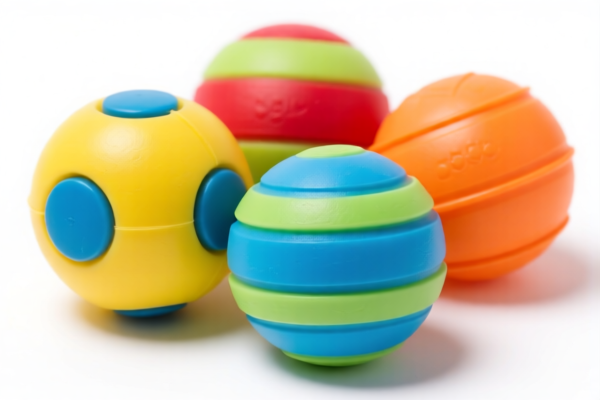| HS Code | Official Doc | Tariff Rate | Origin | Destination | Effective Date |
|---|---|---|---|---|---|
| 3926901000 | Doc | 40.9% | CN | US | 2025-05-12 |
| 3926909989 | Doc | 42.8% | CN | US | 2025-05-12 |
| 3924905650 | Doc | 40.9% | CN | US | 2025-05-12 |
| 9506694000 | Doc | 42.9% | CN | US | 2025-05-12 |
| 9506696020 | Doc | 42.4% | CN | US | 2025-05-12 |
| 9503000071 | Doc | 30.0% | CN | US | 2025-05-12 |
| 9503000073 | Doc | 30.0% | CN | US | 2025-05-12 |




Plastic Dog Balls
Plastic dog balls are toys designed for canine use, typically constructed from various types of plastic polymers. They serve primarily as fetch toys, chew toys, and enrichment items for dogs.
Material
The most common plastics used in their manufacture include:
- Polypropylene (PP): Durable, lightweight, and relatively inexpensive. Commonly used for standard, everyday dog balls.
- High-Density Polyethylene (HDPE): A harder, more robust plastic offering increased resistance to chewing. Often used for balls intended for power chewers.
- Polyvinyl Chloride (PVC): Less common due to potential health concerns associated with phthalates and bisphenol A (BPA), though some manufacturers utilize BPA-free PVC.
- Thermoplastic Elastomers (TPE): Softer, more flexible plastics providing a gentler chewing experience.
Purpose
- Exercise: Facilitate fetch games, promoting physical activity and cardiovascular health.
- Mental Stimulation: Provide entertainment and combat boredom, reducing destructive behaviors.
- Dental Health: Some designs incorporate textures to aid in cleaning teeth and massaging gums.
- Training: Used as rewards during training sessions.
Function
Dog balls function through their physical properties – bounce, roll, and durability. Designs vary to enhance these functions:
- Hollow Balls: Lightweight, providing a high bounce and easy for dogs to carry.
- Solid Balls: Heavier, offering increased stability and resistance to crushing.
- Textured Surfaces: Enhance grip and provide a stimulating chewing experience.
- Sound-Producing Balls: Contain rattles or squeakers to increase engagement.
- Treat-Dispensing Balls: Feature openings to hold treats, encouraging problem-solving and extending playtime.
Usage Scenarios
- Outdoor Play: Parks, yards, beaches, and other open spaces.
- Indoor Play: Limited spaces, providing mental stimulation during inclement weather.
- Fetch Games: Throwing and retrieving with the owner.
- Solo Play: Allowing the dog to play independently.
- Training Exercises: Used as rewards for desired behaviors.
- Puzzle Toys: Treat-dispensing balls provide a challenging activity.
Common Types
- Standard Solid Balls: Basic, durable balls for general play.
- Hollow Balls: Lightweight and bouncy, often with holes for easy carrying.
- Chuckit! Balls: A popular brand known for its high durability and compatibility with ball launchers.
- Treat Balls: Dispense treats as the dog plays, encouraging engagement.
- Light-Up Balls: Illuminated for nighttime play.
- Interactive Balls: Feature complex designs and mechanisms to challenge the dog.
- Jingle Balls: Contain bells or rattles for added auditory stimulation.
- Glow-in-the-Dark Balls: Provide visibility during low-light conditions.
Plastic dog balls fall under articles of plastics and articles of other materials. Several HS codes may be applicable depending on the specific characteristics of the balls.
- 3926901000: This code covers “Other articles of plastics and articles of other materials of headings 3901 to 3914: Other: Buckets and pails”. While not directly dog balls, if the plastic balls are similar in form and function to buckets or pails, this code could apply. The total tax rate is 40.9%, comprised of a 3.4% base tariff, a 7.5% additional tariff, and a 30.0% additional tariff effective April 2, 2025.
- 3926909989: This code covers “Other articles of plastics and articles of other materials of headings 3901 to 3914: Other: Other”. This is a broad category for plastic articles not specifically classified elsewhere. The total tax rate is 42.8%, comprised of a 5.3% base tariff, a 7.5% additional tariff, and a 30.0% additional tariff effective April 2, 2025.
- 9506694000: This code covers “Articles and equipment for general physical exercise, gymnastics, athletics, other sports (including table-tennis) or outdoor games, not specified or included elsewhere in this chapter; swimming pools and wading pools; parts and accessories thereof: Balls, other than golf balls and table-tennis balls: Other: Noninflatable hollow balls not over 19 cm in diameter”. If the dog balls are used for play/exercise and are non-inflatable and under 19cm in diameter, this code is applicable. The total tax rate is 42.9%, comprised of a 5.4% base tariff, a 7.5% additional tariff, and a 30.0% additional tariff effective April 2, 2025.
- 9506696020: This code covers “Articles and equipment for general physical exercise, gymnastics, athletics, other sports (including table-tennis) or outdoor games, not specified or included elsewhere in this chapter; swimming pools and wading pools; parts and accessories thereof: Balls, other than golf balls and table-tennis balls: Other: Other Other”. This is a broad category for plastic balls used for sports/exercise. The total tax rate is 42.4%, comprised of a 4.9% base tariff, a 7.5% additional tariff, and a 30.0% additional tariff effective April 2, 2025.
It is important to determine the specific use and characteristics of the plastic dog balls to select the most appropriate HS code. If the balls are determined to be children’s products, codes beginning with 9503 may be relevant.
Customer Reviews
No reviews yet.